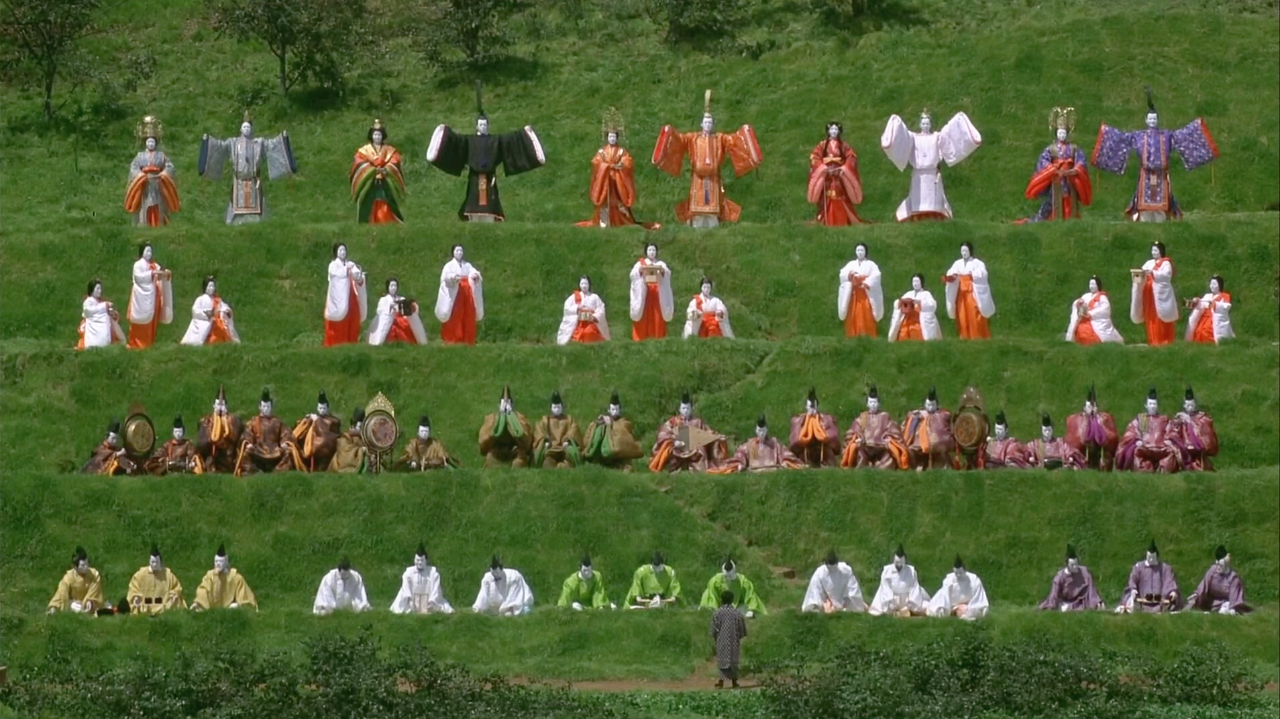
Akira Kurosawa's 1990 anthology film, Dreams, combines the imagery of dreams with the formalism of a hyper-awake state. In the second segment, a collection of dolls are stacked on a hill and perform a complex and slow dance to the music of a gagaku ensemble. When the camera shows us the young boy who is watching—the dreamer whose world we are offered as the condition of our experience—the shot is as still and stately as the music. When the camera takes the dreamer's point of view, simulating his view as he looks up at the dolls, the camera shakes constantly. The dolls are on a hill, and the dreamer’s point of view is situated awkwardly underneath them; the extreme zoom required to show the dolls in any great detail magnifies the jitters of the arms that hold the camera and make the entire performance tremble. This trembling does not in any way resemble the shapeshifting flux of a dream. It resembles the constant hyper-correction of an insect’s cybernetic control—of a mosquito keeping its balance amongst the turbulence of scale by angular movements and adjustments without blurring, error, or the aesthetic mark of gesture.

The images the camera captures always express the technical and kinetic character of the camera itself, and the magnification of the image here serves to articulate every physical hallmark that reminds one of the camera's physical footprint in this contrived universe. And so, the hyper-awake state: what the clarity of the waking eye sees compared with the dream eye, so this hyper-waking compares with the biological function of sight. The film, more than any other Kurosawa I have seen, rejects phenomenal aesthetics, and so it rejects in turn the essence of dreaming. Dreams becomes something like a McLuhan-ist comedy about cameras. It is beyond lucidity. Donald Richie and Joan Mellen write of the film:
Only someone like Kurosawa—someone who is deeply in love with the modernist universe that film implies—could commit something like this to record and have the audacity to claim that it is about dreaming. Only someone so insolently secure in his artistry, after the century of the cinema’s totalising triumph over the visual arts. Writing in 1999, Richie and Mellen detect the disintegration of security that characterises the uneasy birth of the new millennium and look to Kurosawa’s noble, aged, obsolete, and beautiful modernism as a comfort. That Kurosawa does what he does in 1990 is important to them.
The popular music of 1990 seems now to have been the result of a feverish and unconscious identity crisis about authenticity on the part of its artists. Music critic Bill Lamb writes that Sinéad O'Connor’s cover of Nothing Compares 2 U emphasises “a gutsy vocal performance” with a “perfectly understated instrumental arrangement.” The instrumental backing he refers to consists of gated drums and a heavily phased synthetic string arrangement—the phaser effect multiplying what we might have perceived as individual instruments and arranging them milliseconds apart so as to inflate the space of those drones and simulate the combination of stimuli from a thousand compound ears. (We’re flies.) A listener—a critic even—accustomed to the hyperreality of 1990s aesthetics saw no absurdity in describing this synthetic vortex of texture as “understated”.
The “giallo edit” that Coombes describes above is the methodology of editing that one finds in the late 20th century ‘giallo’ films of Italy: literally yellow films. Their yellowness derives from their comparison to the yellow covers of cheap, mass produced mystery and crime novels that became ubiquitous in the 1960s, but the comparison is a superficial one. Aside from the pulp subject matter, many of these films were formally experimental in that their enterprise was a self conscious attempt to disrupt the subjective identification between the viewer’s eye and the film camera. In a grizzly and sordid detective story, the filmmaker is tasked with producing an artificial dissociation through frantic and unnatural edits that frame the moment of murder as a panic attack and the procedural manner of policing as chronic pain. These poles are dialectical: policing is not an auto-immune response to crime, instead both social phenomena interpenetrate as part of alienation and sadism as a social mode. Like Fascism, they are a response to Liberalism in crisis.
The earliest films used their handling of narrative material to literally teach the audience to see in new ways; ways which are set into motion by the experience of watching a film but which continue in some ways beyond the point where the screening ends. Cutting between scenes, rapid alternation between close zooms and wide panoramas, and the nearly simultaneous projection of objects from different angles and at different sizes were not visual phenomena that people had to reckon with before the 20th century, but by the time of giallo artists were tasked with having to dismantle the identification between visual experience and the visual grammar of the cinema that was formed over the last 60-100 years. Given how different the experience of vision is from the experience of watching a film, it is conspicuous that specific measures to draw attention to their difference would need to be taken by artists.
Discourse surrounding the so-called ‘suspension of disbelief’ tends to emphasise the ease with which it can be broken, but this is usually because we are particularly sensitive to the plausibility of a narrative’s causal logic and the authenticity of an actor’s emotion. When it comes to the methodology of the edit most audiences are remarkably easygoing. Reminding the audience that they are watching a movie using the formal language of film, inviting them to consider the psychologies of control and spirituality in this enterprise, is a curiously difficult business.
In part this is due to the brain’s incredible capacity for assimilating epistemological frameworks: the question of vision is one of the simplest ways to explain this. The human eye is much, much worse than the richness of our experience suggests it is. Contemporary research into optics reveals that the vast majority of our field of vision is extremely blurry and lacking colour information. If you form a ring from your thumb and index finger and hold it out at arm’s length, looking through, the little ring you see in the centre of your vision is pretty much the whole extent of your colour vision, with all the surrounding periphery filled in by the brain according to rough guesswork. What’s more, due to the extremely high processing demand of the visual system we are only capable of seeing one colour at a time, so all of our polychromatic experience is derived from the brain layering snapshots of colour together into a composite image that takes hundreds of milliseconds to actually form. I have laid out some of the ways in which the colour we experience is a mental construct here, but I could multiply many more examples for the ways in which we perceive surface detail, relative dimension of objects and distance, the recognition of discrete symbols, our almost total blindness whenever our eyes move, and other artefacts of vision that for the sake of brevity I will leave out of this text.
The reason why this is surprising to us is that the purpose of vision is to inform us about the state of the world, and so the brain does everything it possibly can to approximate the way the world actually is, rather than displaying the images our eyes actually take in. This means that the phenomenology of vision is always a negotiation the brain makes between sensory input and more abstract cognitive processing about the way we expect the world to behave. For instance, readers of English will perceive more detail slightly to the right of the centre of their focus when reading text because the brain is anticipating that the line of sight will move from left to right, while for readers of Arabic the reverse is true. For readers of both languages, the brain switches between these two modes according to the text in question, which means that the nuts and bolts of our visual processing system, which evolved millions of years ago, are able to dynamically respond to the orthographic conventions of scripts invented only a few thousand years ago. It is probably still an astonishing pedagogical feat that filmmakers were able to teach people how to intuitively feel film within only a few decades, but as usual there is a precedent for this in nature.
Paul Gagneux wrote somewhere that a constant feature of both modernism and postmodernism as cultural modes is the acceleration of the natural, I suspect he might have liked the identification I make above. I wonder also how Henri Bergson might have reacted to the recent advances in understanding vision: he was in some sense vindicated by the proof that all phenomenal experience takes place in continuous duration, and that there is no single moment of ‘now’ that the brain has access to because it has to construct the present moment out of parts derived from the past. The present is not updated in totality as time marches from instance to instance, but piecemeal: as tiny sections are replaced bit-by-bit over the milliseconds like the scanlines of a nonlinear cathode-ray-tube TV. In Sexus Henry Miller has a line: “we must die as egos and be born again in the swarm”, and Bergson might have enjoyed that if it were possible for a moment in time to write a manifesto, this could have been part of it.
The giallo edit, in the moment of murder, gives us eyes everywhere at once. The camera cuts rapidly between slightly different angles of the same scene, slowing down time and reifying the materiality of the scene by describing it in more and more detail. In the production ethic of Nothing Compares 2 U the digital effects rack gives us a chorus of multiplied synthetic orchestras, more massive than any existing group of musicians but simultaneously less substantial. Both take the techniques the 20th century cinema developed to engender a heightened subjective identification between audience and text and multiply them beyond the point of credibility. Both resemble satire, and like any good satire both have been interpreted as indistinguishable from the texts from which they derive. The giallo works were mostly derided as cheap and venal junk food, while the post-intimacy after-image of vulnerability in Nothing Compares 2 U was mistaken for something visceral. I now invite you to consider Benito Mussolini.

This sculpture looks like a doorknob when you view it from most angles. The practitioners of the Arts and Crafts movement of the late 19th century mourned the loss of decorative style that the rise of mass produced commodities engendered; the 20th century’s most mature response, that of the Bauhaus, accepted the historical premises but sought to reconcile the future and the past instead of rejecting both in favour of a present in suspended animation. The Futurist movement in Italy arguably tried to do both at once, which is why it is so at home as the aesthetic vehicle for fascism. When viewed side-on, that rippling black doorknob becomes Benito Mussolini. His profile has been stretched into a uniform continuum that transforms the iconography of Janus, the two faced God that looked into the future and the past at once, by collapsing the dichotomy and setting him facing every direction at once. The doorknob sees into every room in your house.
Because Futurism is essentially misanthropic, artists (with their imperfect powers of dictation) can produce works that either denigrate the human being or they can produce works which seem to have come from a world in which there are no human beings to denigrate—or at least a world in which humans are too low to bother with making art about at all. Profilo continuo unites the religious obsession with speed with a face, which appears to buck this trend. But to the Italians of the 1930s Mussolini was not really a human being, nor was he a god. For the most full-throated Fascists, he was just (and no less than) the basis of their subjectivity.
We find in the Neoliberalism of the 21st century that all people must confront each other on the terms dictated by their status as the owners of commodities. This is the sense of codified subculture in which items of fashion, favourite pieces of media, and even modular propositions about morality are leveraged to give the commodity owner cultural capital within their social cliques. Fascism is the runaway multiplication of Liberalism, an uncontrolled and unstable cancer that lacks the subtlety of Neoliberalism. As such, it has a transformative effect on individualism: as in the Profilo continuo, where the multiplication of speed has a smoothing effect and produces an object of complete and empty stillness, the fever pitch of personality is not the reduction of individuality to an archipelago of isolated egos, as we might expect. It is a single, symmetrical, infinite Man. The subjectivity of il Duce or der Führer produces in that Man the protagonist of reality.
Three Trains of Thought From the Barbican, 7th of October
The Historical Peculiarity of the Greek Chorus
Film Acting and Identity